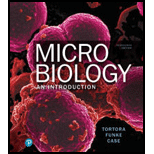
Microbiology: An Introduction Plus Mastering Microbiology with Pearson eText -- Access Card Package (13th Edition) (What's New in Microbiology)
13th Edition
ISBN: 9780134688640
Author: Gerard J. Tortora, Berdell R. Funke, Christine L. Case, Derek Weber, Warner Bair
Publisher: PEARSON
expand_more
expand_more
format_list_bulleted
Textbook Question
Chapter 6, Problem 3CAE
The number of bacteria in saliva samples was determined by collecting the saliva, making serial dilutions, and inoculating nutrient agar by the pour plate method. The plates were incubated aerobically for 48 hours at 37°C.
| Bacteria per ml Saliva | ||
| Before UsingMouthwash | After UsingMouthwash | |
| Mouthwash 1 | 13.1 × 106 | 10.9 × 106 |
| Mouthwash 2 | 11.7 × 106 | 14.2 × 105 |
| Mouthwash 3 | 9.3 × 105 | 7.7 × 105 |
What can you conclude from these data? Did all the bacteria present in each saliva sample grow?
Expert Solution & Answer
Want to see the full answer?
Check out a sample textbook solution
Students have asked these similar questions
C
MasteringHealth MasteringNu X
session.healthandnutrition-mastering.pearson.com/myct/itemView?assignment ProblemID=17396422&attemptNo=1&offset=prev
If left untreated, most HIV-infected individuals will develop AIDS. Current treatments are focused on highlyactive antiretroviral therapy (HAART). HAART usually consists of an orally delivered drug cocktail containingtwo different reverse transcriptase inhibitors and one other drug, such as a protease inhibitor.
Question: Develop a pharmacokinetic model of HAART treatment. Consider all 3 drugs. Make sure to include adiagram that illustrates your thinking, state all assumptions, and define your variables. Whatparameters would you need to know to find the concentration of drug in the plasma? In the T cells?(You do not need to write out or solve any equations.)
not use ai plesea
Chapter 6 Solutions
Microbiology: An Introduction Plus Mastering Microbiology with Pearson eText -- Access Card Package (13th Edition) (What's New in Microbiology)
Ch. 6 - Prob. 1RCh. 6 - Prob. 2RCh. 6 - Prob. 3RCh. 6 - Seven methods of measuring microbial growth were...Ch. 6 - By deep-freezing, bacteria can be stored without...Ch. 6 - A pastry chef accidentally inoculated a cream pie...Ch. 6 - Nitrogen and phosphorus added to beaches following...Ch. 6 - Differentiate complex and chemically defined...Ch. 6 - DRAW IT Draw the following growth curves for E....Ch. 6 - NAME IT A prokaryotic cell hitched a ride to Earth...
Ch. 6 - Two culture media were inoculated with four...Ch. 6 - Two culture media were inoculated with four...Ch. 6 - Use the following graph to answer questions 3 and...Ch. 6 - Use the following graph to answer questions 3 and...Ch. 6 - Assume you inoculated 100 facultatively anaerobic...Ch. 6 - The term trace elements refers to a. the elements...Ch. 6 - Which one of the following temperatures would most...Ch. 6 - Which of the following is not a characteristic of...Ch. 6 - Which of the following types of media would not be...Ch. 6 - An organism that has peroxidase and superoxide...Ch. 6 - E. coli was incubated with aeration in a nutrient...Ch. 6 - Clostridium and Streptococcus are both...Ch. 6 - Most laboratory media contain a fermentable...Ch. 6 - Flask A contains yeast cells in glucose-minimal...Ch. 6 - Clinical Applications and Evaluation 1. Assume...Ch. 6 - Heat lamps are commonly used to maintain foods at...Ch. 6 - The number of bacteria in saliva samples was...
Additional Science Textbook Solutions
Find more solutions based on key concepts
Practice Problem 1.22 Which of the following alkenes can exist as cis-trans isomers? Write their structures. Bu...
Organic Chemistry
Why do scientists think that all forms of life on earth have a common origin?
Genetics: From Genes to Genomes
Describe the role and impact of microbes on the earth.
Microbiology Fundamentals: A Clinical Approach
On what molecule does the anticodon appear? Explain the role of this molecule in protein synthesis.
Human Physiology: An Integrated Approach (8th Edition)
Gregor Mendel never saw a gene, yet he concluded that some inherited factors were responsible for the patterns ...
Campbell Essential Biology (7th Edition)
Knowledge Booster
Learn more about
Need a deep-dive on the concept behind this application? Look no further. Learn more about this topic, biology and related others by exploring similar questions and additional content below.Similar questions
- (A) 25 20 20 15 NPP (Mg C/ha/yr) 10 10 5 0 0 2,000 4,000 6,000 ECOLOGY 4e, Figure 20.11 (Part 1) 2017 Sinauer Associates, Inc. Average annual precipitation (mm) 8,000arrow_forwardexplain the cascade of events (starting with relaxing trade winds) that occurs during El Niño in the eastern Pacific (off the coasts of California/North America and Peru/South America) and which lead to food-chain collapse - start with changes in the physical/oceanographic conditions, andthen systematically describe the cascading effects at each level of the food chain -arrow_forward3) Which statement(s) about the Pacific Decadal Oscillation (PDO) is/are TRUE? CIRCLE ALL THAT APPLY. A. It is a major driver of salmon populations in the Pacific B. It affects sea surface temperatures in the eastern Pacific C. Its cycles typically do not last as long as those of ENSO D. Evidence that it has occurred over many centuries has been gathered from tree ring dataarrow_forward
- 4.arrow_forward2arrow_forward1. 2. 3. Marine fish cells are hypotonic compared to their seawater environment; their cells lose water by osmosis and gain solutes. If you add heterotrophic respiration and autotrophic respiration together and then subtract that value from gross primary productivity, then you have a more refined estimate of ecosystem carbon storage than NEE. Differential heating due to the earth's tilt generates the global wind AND oceanic circulation patternsarrow_forward
arrow_back_ios
SEE MORE QUESTIONS
arrow_forward_ios
Recommended textbooks for you
- Basic Clinical Lab Competencies for Respiratory C...NursingISBN:9781285244662Author:WhitePublisher:Cengage
 Microbiology for Surgical Technologists (MindTap ...BiologyISBN:9781111306663Author:Margaret Rodriguez, Paul PricePublisher:Cengage Learning
Microbiology for Surgical Technologists (MindTap ...BiologyISBN:9781111306663Author:Margaret Rodriguez, Paul PricePublisher:Cengage Learning



Basic Clinical Lab Competencies for Respiratory C...
Nursing
ISBN:9781285244662
Author:White
Publisher:Cengage


Microbiology for Surgical Technologists (MindTap ...
Biology
ISBN:9781111306663
Author:Margaret Rodriguez, Paul Price
Publisher:Cengage Learning

Serology 101: Testing for IgG and IgM antibodies; Author: Beckman Coulter Dx;https://www.youtube.com/watch?v=LtqKB-qpJrs;License: Standard youtube license